The Town of Lillet
In this beautiful area of Berguedà, we can enjoy natural spaces, fantastic cuisine and even hidden works by the great architect Antoni Gaudí.
Located at an altitude of 843 m, La Pobla de Lillet is a town in Alto Berguedà, crossed by the River Llobregat. It limits to the north with Castellar de n'Hug, to the south with Castell del Areny, to the east with Gombrèn and Sant Jaume de Frontanyà and to the west with Guardiola de Berguedà.
This wonderful enclave is ideal for mountain tourism, to go skiing on the slopes of La Molina or to enjoy the architecture of the great Antoni Gaudí.
Thus, the tourist offer is varied and spectacular, near La Pobla de Lillet you can access the points of interest that we detail below, but it is also a very good option to get lost in its spectacular natural surroundings.
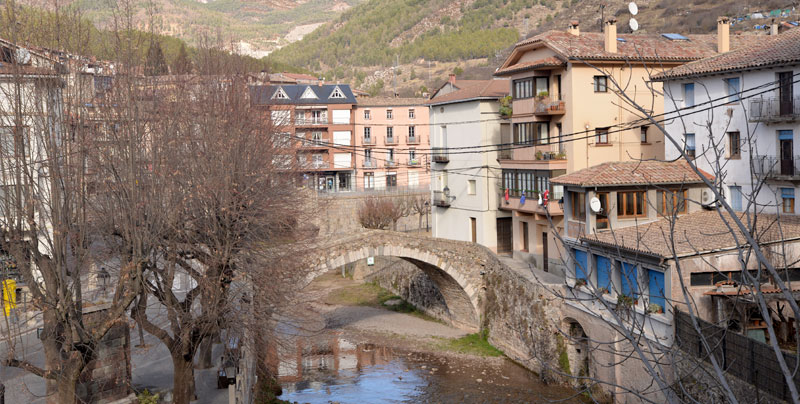
Historic center of Pobla de Lillet
The historic center of Pobla de Lillet is one of the prettiest of the pre-Catalan Pyrenees villages. Getting lost in its alleys and looking at all the little details of this beautiful town that dates back to the 13th century is really nice.
The most central neighborhood is also the one with the most atmosphere: shops, restaurants, bars and various businesses can be found in these streets of Pobla de Lillet.
The cobbled streets of the historic center of Pobla de Lillet retain all the charm of this old town located on the so-called "El Pujolet" hill.
Walking through Pobla de Lillet, we can also enjoy contemplating the bridges of the town, since bordering the road that crosses it, we also find the Llobregat river or tributaries such as the Arija. Each of its bridges is considered a cultural asset of local interest or also as an architectural heritage of Catalonia.
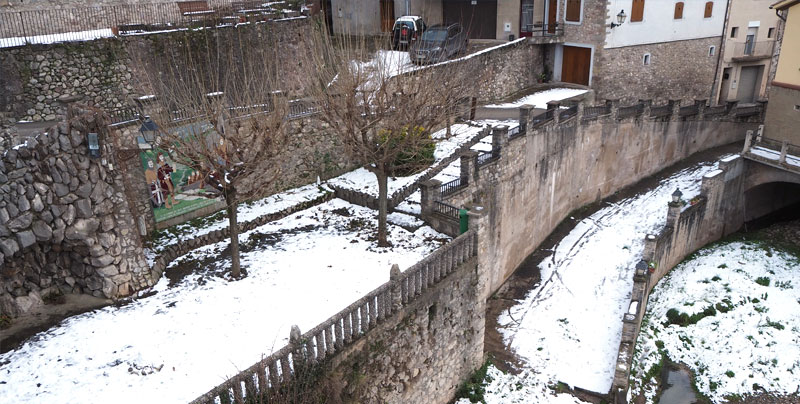
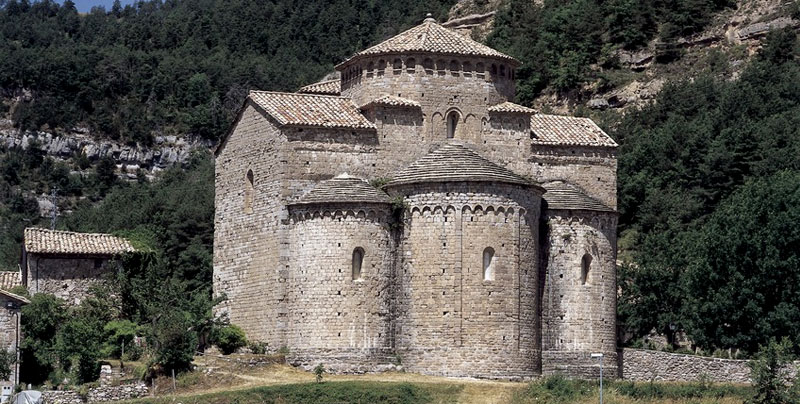
Sant Jaume de Frontanyà
One of the smallest towns in Catalonia in a privileged natural enclave. Located in the Berguedà region, Sant Jaume de Frontanyà is surrounded by tributaries of the Merlés stream.
The church and the cemetery are its central points, next to the Plaza del Ayuntamiento and the Plaza de la Iglesia. Its church built in 1070 was the seat of a community of monks. This church has the particularity of having a dome with twelve sides, unique in Catalonia.
With about 25-30 inhabitants, this beautiful enclave is located at an altitude of 1,072 m and its municipal term has 21.9 km2. The town is surrounded by pine forests and pastures for cattle.
Castellar de n'Hug
Castellar de N'Hug is one of the most charming towns in the country. In it we can visit the sources of the source of the Llobregat river or witness its famous sheepdog contest. This beautiful municipality located at an altitude of 1,390 m is located in the extreme north-east of the Berguedà region.
Located in a rugged but beautiful natural space, in its surroundings we find red pine, beech, oak, poplar and ash forests. We can also enjoy watching the cattle graze on its meadows in summer, or dedicate ourselves to collecting mushrooms in autumn.
Practically the entire town has been restored respecting the architecture of the municipality. Pretty cobbled streets with houses with wooden shutters and roofs with typical Catalan tiles.
From Castellar de n'Hug you can also enjoy magnificent views of the Cadí Moixeró natural park or the start of the Llobregat valley.
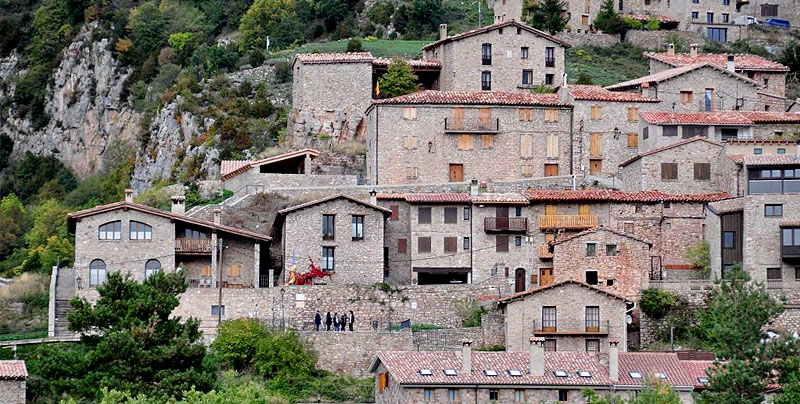
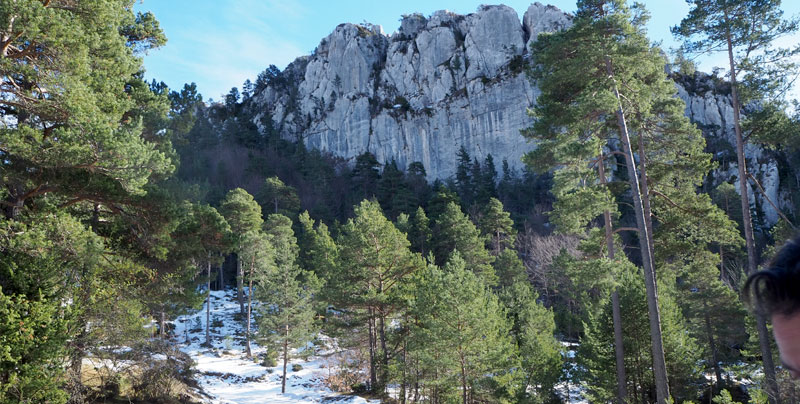
Catllaràs mountain range
This protected mountain range with great scenic value is full of routes to be followed on foot. With a height of 1,700 meters, it is full of spectacular dense forests. The Sierra del Catllaràs is home to deer and a space loved by hikers.
From Catllaràs we can see Pedraforca and Vallfogona or Cadí Moixeró to the south. At its northern end we find the Sierra de Falgars, on the south bank of a young Llobregat river.
In this spectacular mountain range we can find a great diversity of trees: oak and pine forests that are distributed occupying the sunny areas and valley bottoms, but there are also beech trees in less sunny areas.
It is a passage area for many animals, we find, for example, the deer, the capercaillie or the marten. And hiking lovers can walk along the GR 4 and GR 241 trails that cross the mountains.
Xalet del Catllarás
In the Sierra del Catllaràs, we find a hidden pearl of architecture. It is a chalet designed by Antoni Gaudí in 1902.
Gaudí devised it during his naturalist stage, in the first decade of the 20th century. The Xalet del Catllaràs is registered as a Cultural Asset of Local Interest (BCIL) in the Inventory of Cultural Heritage of Catalonia.
Antoni Gaudí's visit to Pobla de Lillet took place thanks to his patron, Count Eusebi Güell, who owned the Asland portland cement factory in the area. The chalet was born from the need to build a refuge chalet for the engineers who worked on it, who had to spend long stays away from their homes, on land near the factory. This curious building has the shape of a pointed arch and a ceramic brick vault and was originally covered with river stone. After several uses, in October 2020 it was restored, recovering its original appearance designed by Gaudí.
Leaving Pobla de Lillet, after a drive of about 9 km through the mountains, you reach the plain where this Gaudí building is located.
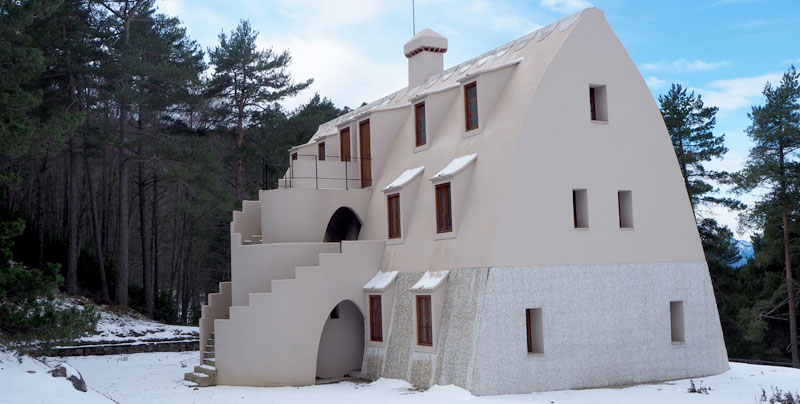
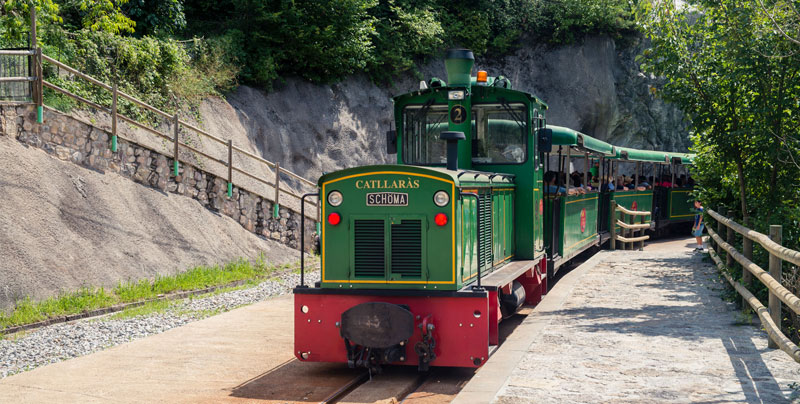
The cement train
The “Cement Train” makes a journey of about 20 minutes. This is a historic line that linked the old Asland cement factory in Castellar de n'Hug with Guardiola de Berguedà, the starting point of the narrow gauge railway line to Berga and Manresa.
The train is managed by Ferrocarriles de la Generalitat de Catalunya, and its route lasts 3.5 km, stopping at the following stations:
- La Pobla de Lillet
- The Pobla Center
- Artigas Gardens
- Cement Museum-Castellar de n'Hug
This train works thanks to a diesel locomotive and can carry a maximum of 100 passengers each way. The train runs on weekends and holidays, from March to November. But punctually it opens for schools or groups by prior reservation.
Artigas Gardens
The Artigas gardens are another printing house left by Gaudí in Pobla de Lillet. These gardens were designed by the architect in gratitude to his hosts, Mr. Artigas. In these gardens, nature and architecture merge in perfect harmony with the help of the waters that flow from a fountain next to the Llobregat river.
These gardens were made between 1905 and 1906, during Gaudí's stay at the house of the textile industrialist Joan Artigas y Alart in gratitude for his hospitality.
The gardens of Artigas are ideal for getting lost on a long walk, with corners to sit, meditate and enjoy the cool air in summer. These corners are diverse; At the highest point we find the Glorieta, which serves as a gazebo, in the Cave we can hide among its catenary arches, in the Waterfall, observe stones placed with the Gaudinian trencadís and everything adorned with plant motifs. There is also a picnic area next to an arched bridge. Everywhere you look, the details fused with nature are present in this dreamlike place.
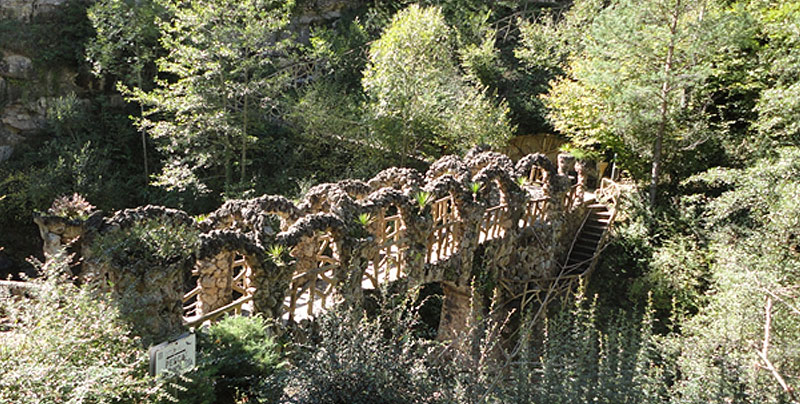
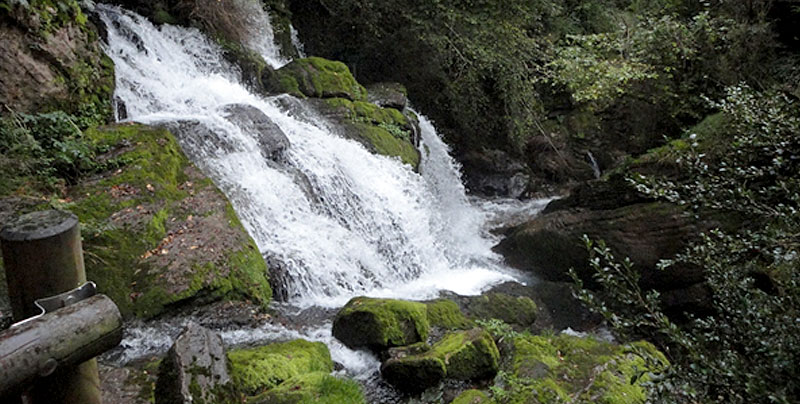
The Llobregat Fountains
This is the source of the Llobregat river at an altitude of about 1,300 metres. Located between Lleida, Girona and Barcelona, in spring, when the thaw begins, you can take a beautiful tour full of natural waterfalls and pools of water, being able to finish off the excursion with a beautiful visit to Castellar de n'Hug or a hiking route or in bicycle through the Sierra del Cadí.
To access the Fonts del riu Llobregat, you can get there by car, although it is advisable to go on foot along the marked path that leaves the town of Castellar de n'Hug. The path is perfectly indicated.
Without a doubt, it is an ideal place to enjoy the vegetation, the sound of the water and the singing of the birds.
Church of Santa María de Lillet and the Church of San Miquel
Following the B402 road towards Coll de Merolla, leaving La Pobla de Lillet, we arrive at the monastery of Santa María de Lillet.
This old monastery in Berguedà appears for the first time in documents from 819. The lords of the castle of Lillet were the main benefactors of the monastery.
The current church was built in the 12th century, in the Romanesque style, with a single nave and a Latin cross plan. The visit of the monastery is perfect to visit with a walking tour from Pobla de Lillet.
About 150 meters from the monastery, we find the roundabout of Sant Miquel, very well preserved. According to an inscription on the altar, the church was consecrated on May 9, 1000. It is a circular building with a semicircular apse, one of the few extant examples and one of the smallest (6, 5 m outside diameter and 4.7 m inside).
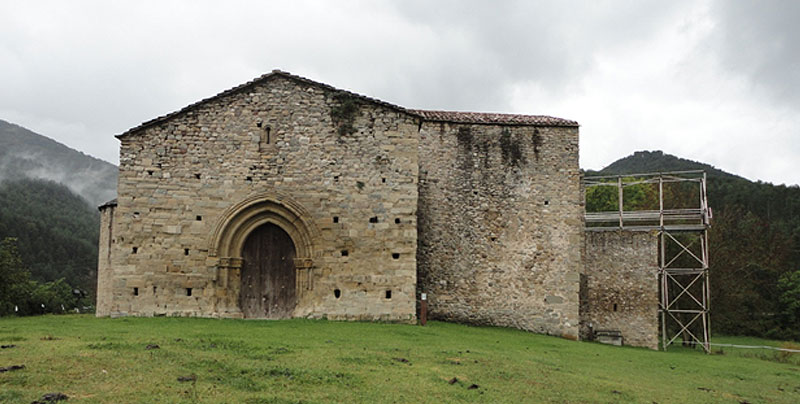
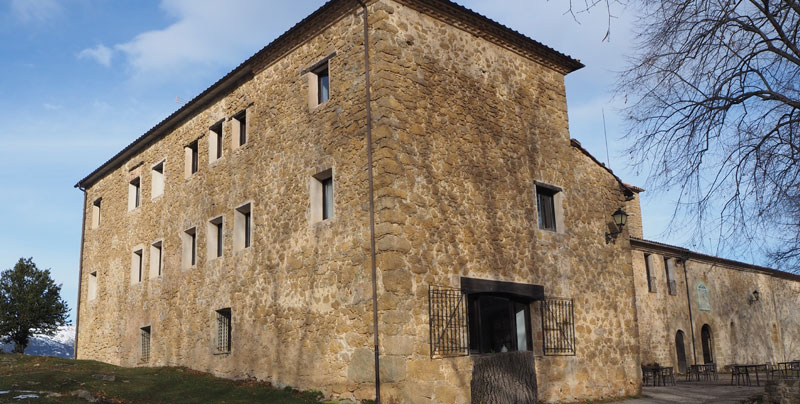
Falgars Sanctuary
It is a splendid place with views of the Pyrenees and Pedraforca. It is a medieval sanctuary made up of a church and inns. Today they function as a rural hostel.
Inside the sanctuary, we find an image of the Gothic Virgin, made of alabaster and dated to the 15th century.
The sanctuary has thick stone walls and a gabled roof with Arabic tiles. Some rooms are covered with a vault.
This beautiful sanctuary can be found about 9 km from Pobla de Lillet following the B402 road.
Cement Museum
Located in Clot del Moro, the Ciment Museum is located in the old Asland factory, in Castellar de n'Hug. This factory worked for 71 years until 1975, supplying cement at a time of strong growth in industrial society. The building is spectacular and is located in an incredible enclave.
Currently, the factory is part of the National Science and Technology Museum of Catalonia (MNACTEC), and houses the Castellar de n'Hug Ciment Museum, inaugurated in 2002. The factory and its surroundings were declared cultural asset of national interest in 2005.
A visit to the museum allows you to understand the impressive set of remains of this industrial complex.
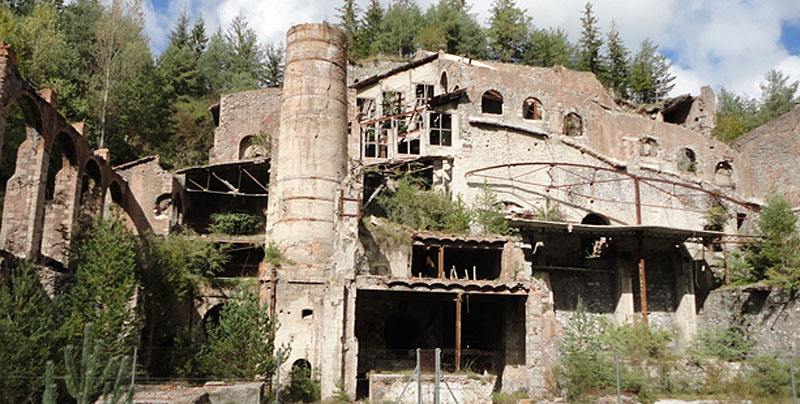
Frequently asked questions about rural tourism in La Pobla de Lillet
Which Gaudí monuments can I visit nearby?
You can visit the Catllaràs Chalet and the Artigas Gardens, both modernist works by Antoni Gaudí located in Pobla de Lillet or Castellar de n’Hug.
Where does the Llobregat River originate?
The source lies in Castellar de n’Hug, about 9 km by mountain from Pobla, accessible by car or via a marked hiking trail.
What is the Cement Train?
It’s a historic tourist train running between Pobla and the Cement Museum in Castellar de n’Hug. Operates weekends and holidays (March–November), bookable for groups.
What other historic monuments are there?
The old town features the Baroque parish church of Santa María, the round Sant Miquel chapel, and the 13th-century remains of Pobla Castle.
Are there recommended mountain trails?
Yes: trails to the Artigas Gardens, Sanctuary of Santa María de Falgars (~9 km), the former Monastery of Santa María, plus paths to Romanesque bridges.